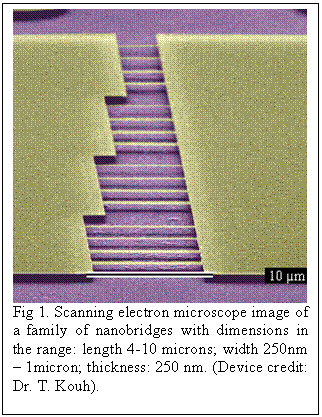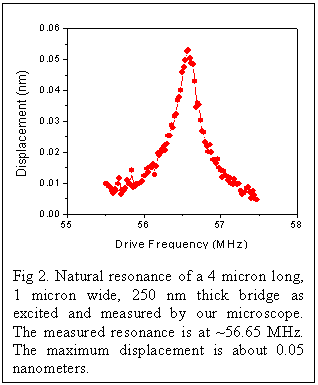151st ASA Meeting, Providence, RI
Sound from Light: Playing Notes on Nanoscopic Wires
A. SampathKumar - ashrex@bu.edu
Popular version of paper 2pBB6
Nearly all objects vibrate at a characteristic frequency when struck or strummed or somehow disturbed. This natural resonance frequency depends upon many factors — such as geometry, material properties, constraints. For a harp string, for example, this frequency is dictated by the linear density, length, and tension in the string. A vibrating harp string will disturb the air around it, and give rise to sound waves — which come to our ears as musical notes. A middle C, for example, has a vibration frequency of about 261 hertz. In general, any vibrating object will create sound waves. If the amplitude of these vibrations is large enough and the frequency is within the correct range, then the emitted tones will be audible. Imagine now, scaling the harp string down a million times in length — while roughly keeping the aspect ratios. If you somehow plucked this nanoscopic wire, it would vibrate much like its macroscopic counterpart, but at a characteristic frequency roughly 18 octaves (about a factor of 270,000) above middle C. The real problem is how to pluck these wires — let alone hear their high pitches. Our team at Boston University has built a new light microscope for exactly this purpose: plucking nanoscopic wires and listening to their vibrations. We use two tightly focused light beams, one to pluck the wires, and another to listen to their vibrations. The nanoscopic wires — in reality bridges of rectangular cross section (see Fig.1) — are carved out of silicon wafers and then coated with a thin layer of chromium metal. The smallest bridge tested was a mere 2.5 microns long and had a 250 nanometer by 250 nanometer cross-section (A nanometer is one billionth of a meter). To fabricate these, we used electron beam lithography with resolution well below that obtained by light.
The physical plucking mechanism at work in our microscope is the so-called photothermal effect — not at all similar to a guitar pick. The light beam hits the nanoscopic wire and causes a local temperature rise. This temperature rise, in turn, generates a thermal expansion both in the silicon wire and the chromium coating. Since these materials expand differently when subjected to the same temperature change, a local stress is generated. This local stress, in essence, is the cause of the local force responsible for the motion. In our microscope, by modulating the intensity of the light beam at a desired frequency, and thus, heating and cooling the structure, we are able to induce vibrations at this frequency. When the modulation of the light matches the natural resonance frequency of the nanoscopic wire, the vibrations are greatly enhanced (see Fig. 2). Using this technique, we have excited resonances at frequencies up to 70 million times per second (70 megahertz). In some cases, by tuning the light frequency and the plucking position just right, we were able to excite the so-called first harmonic modes. You can produce these pitches on the low strings of a guitar as well: touch the string lightly at its midpoint, pluck the string close to one end, and release the first finger as soon as you have plucked. The finger in the middle of the string produces a node there, and allows you to excite the first harmonic mode. Apart from its musical significance, tiny bridges vibrating at high frequencies offer great potential in sensing, optics and electronics applications. These are miniscule devices with attractive characteristics such as reduced mass and power dissipation as well as inherent speed and precision. One application that we have been pursuing using these nanoscopic bridges is mass sensing. The available sensitivity appears to be suitable for weighing a virus, a protein or even a single molecule simply by loading them onto one of these devices. Such sensor elements could turn into powerful new tools in medical diagnostics. Nanodevices resonating at microwaves (up to several billion cycles a second) could also find use in optical and electronic circuits. Modulating the flow of light or electrons at high frequencies is an important task in today’s technology. Computers, for example, us e the vibrations from a bulk crystal — roughly the size of a penny — to set their tempo for handling each one of the many convoluted operations. A vibrating nano-bridge might do the same job in less space with much less power consumption. This paper will be presented at the 151st ASA meeting on June 6, 2006 at 3:50 P.M. in Session 2PBB: Biomedical Ultrasound/Bioresponse to Vibration, Physical Acoustics, and Signal Processing in Acoustics: Sensing and Imaging Using Light and Sound. Ballroom D.
Additional Contact Information: |

